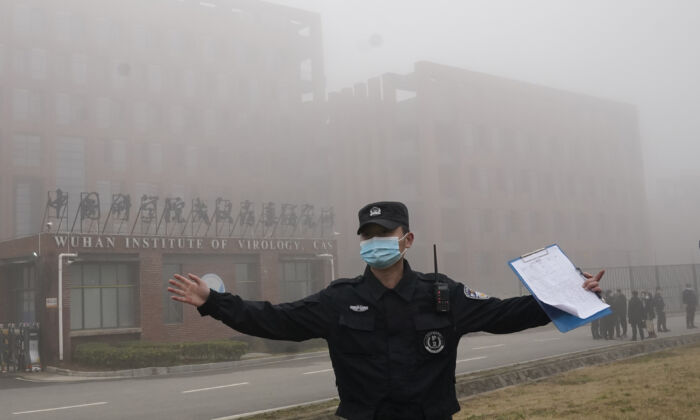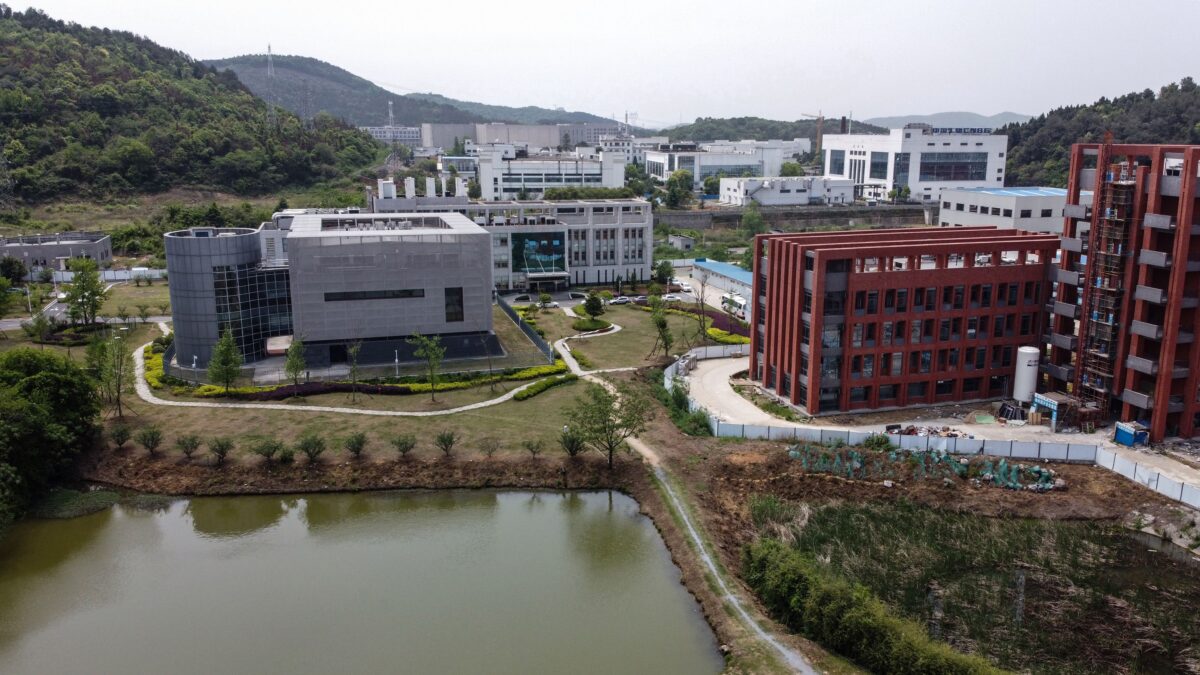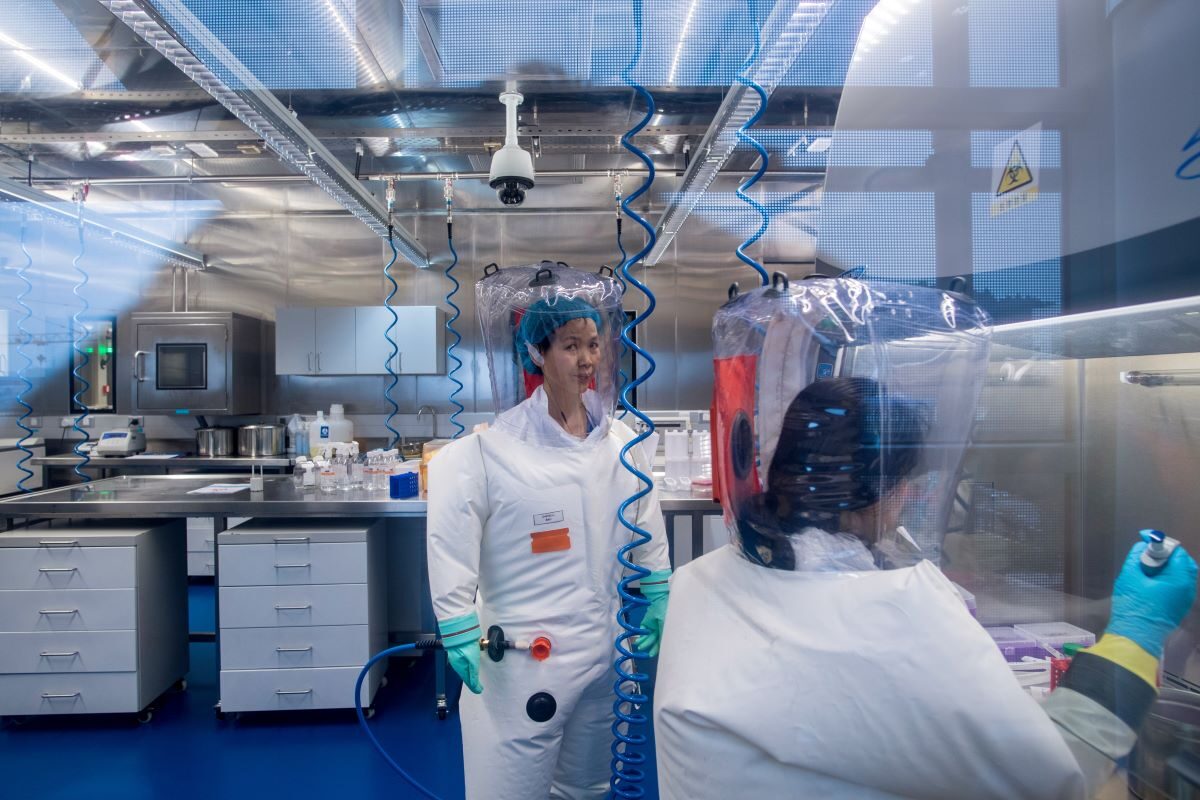
A security person moves journalists away from the Wuhan Institute of Virology after a World Health Organization team arrived for a field visit in Wuhan in China’s Hubei Province, on Feb. 3, 2021. (Ng Han Guan/AP Photo) Thinking About China
Anders Corr May 26, 2021 Updated: May 27, 2021 biggersmallerPrint
Commentary
On May 24, the Wall Street Journal published seven key sets of facts that demonstrate that Wuhan virologists, who claim to have been conducting analyses that would help develop vaccines for a then-non-existent pandemic, might have taken undue risk through gain-of-function research or lax lab safety standards, that sparked the COVID-19 pandemic that killed almost 3.5 million people worldwide, and counting. At the very least, the Wuhan Institute of Virology (WIV) is culpable for omitting crucial data that would help the world determine the virus’s origins.
First, six workers from a bat-infested copper mine in the Mojiang region of China, got sick in 2012, and three died. All the sick miners had similar symptoms. A CT scan “revealed severe pneumonia, with the same lung markings now seen in many COVID-19 patients,” according to evidence seen by the Journal. Four miners tested positive for SARS antibodies.

Second, WIV scientists suspected a bat-borne coronavirus, and collected samples from 276 bats of at least six different species, from the area. “They extracted genetic material from the samples and sequenced fragments,” according to the Journal. “Half of the samples tested positive for coronaviruses,” including a SARS-type one. “Critically, all six bat species showed evidence of coronavirus co-infection, the researchers found. In other words, the virus could easily exchange genetic material with similar ones to create a new coronavirus—an environment ripe for the creation of new viruses that could potentially infect humans.”
Dr. Shi Zhengli, the top WIV bat coronavirus expert, led that research. Dr. Shi claims to have retested the miners, thereby rejecting the hypothesis that they were infected with SARS-CoV-2.
Third, the WIV once had a public database of 22,000 samples and virus sequences. 15,000 of these were from bats. In September 2019, WIV took the database offline, ostensibly due to over 3,000 cyberattacks.
Fourth, Dr. Shi recently said her team found eight additional SARS-like coronaviruses at the mine. “Many scientists question why the WIV didn’t announce the existence of those viruses earlier, as well as their connection to the mine, and why they waited so long to allow scientists to examine their sequences,” according to the Journal. “Some have noted that Dr. Shi has repeatedly asserted that the Mojiang miners had a suspected fungal infection, not a virus, contradicting research papers at the time and Dr. Shi’s update in [the journal] Nature, which said the miners were thought to have a virus.” Dr. Shi was not fired, so WIV is responsible for her apparent dissimulation.
Fifth, WIV conducted gain-of-function research. Such research makes viruses more lethal and infectious, under highly-controlled circumstances, ostensibly in order to develop vaccines. Some scientists, according to the Journal, say that research papers reveal that WIV employees “were combining some bat coronaviruses they had cultured with genetic material from others.”
“Dr. Shi has publicly described doing experiments, including in 2018 and 2019, to see if various bat coronaviruses could use a spike protein on their surfaces to bind to an enzyme in human cells known as ACE2,” according to the Journal. “That is how both the SARS virus and SARS-CoV-2 infect humans.” The experiments required the combination of a bat coronavirus and the spike protein of another, then the infection of genetically-engineered mice containing human ACE2, according to Dr. Shi.

According to the Journal, “Ralph Baric, a microbiologist at the University of North Carolina … worked with the WIV on a study to create an artificial coronavirus that infected human cells in the lab.” Dr. Baric has some explaining to do. Scientists should not collaborate with totalitarian regimes on dangerous biological research.
Sixth, three WIV researchers got sick in November 2019 and were hospitalized with symptoms consistent with both seasonal flu and COVID-19. This information, obtained by the Journal, was likely from Australia’s intelligence service.
Seventh, Chinese authorities are obstructing researchers and reporters from accessing the copper mine and environs (although one heroic Journal reporter recently managed to make it there by mountain bike to take a photo). Officials detained him for five hours and deleted the photograph.
Scientists are looking at these facts, raising concerns, and demanding more data.
Ian Lipkin, infectious-disease specialist at Columbia University, said WIV experiments on coronaviruses in labs might have been at a lower biosafety level than is required in the United States.
Dr. Ralph Baric believes that the genetic structure of SARS-CoV-2 indicates a wild origin and natural evolution to infect humans, but that a “rigorous investigation would have reviewed the biosafety level under which bat coronavirus research was conducted at WIV … detailed information on the training procedures with records, the safety procedures with records and strategies that were in place to prevent inadvertent or accidental escape,” according to the Journal.
Virologist Bernard Roizman at the University of Chicago told the Journal, “I’m convinced that what happened is that the virus was brought to the lab, they started to work with it … and some sloppy individual brought it out. They can’t admit they did something so stupid.”
Clearly, the gathering and public revelation of more evidence is needed to address these concerns. The WHO-led team tasked with investigating the virus’s origin, only spent three hours at WIV. It was unable to do antibody tests on animals and people near the copper mine. Even WHO Director-General Dr. Tedros Adhanom Ghebreyesus criticized his own team’s investigation as inadequate.
China’s gain-of-function research should be a concern to all. According to the Journal, “Critics say the risk of harmful, genetically enhanced viruses leaking from the lab is too great” to justify any benefit from gain-of-function research that assists in developing vaccines for future potential pandemics.
In 2014, the U.S. National Institutes of Health (NIH) stopped funding gain-of-function research, only to reinstate it in 2017 though under the greater strictures of an expert review panel. China’s restrictions on gain-of-function are less rigorous, and its science is often substandard. It can and is hijacked by an unethical Chinese military under Xi Jinping’s control.
In sum, the WIV lab researchers did not disclose their collaboration with the Chinese military, released discrepant data that appears to evidence dissimulation, and are not being transparent. They failed to provide full access to evidence that could explain the origin of the virus.
Most scientists do believe the lab-leak hypothesis is unlikely relative to natural human-to-animal spillover, which happens much more frequently.
But until China improves its scientific and political ethics, it has no business conducting gain-of-function research. Western scientists should immediately stop putting such powerful technologies into the hands of potentially sloppy and military-linked scientists in China, when the stakes are so high. Continuing to conduct collaborative scientific research with them, given what we know today, is an unjustified risk for the world.
Anders Corr has a BA/MA in political science from Yale University (2001) and a Ph.D. in government from Harvard University (2008). He is a Principal at Corr Analytics Inc., Publisher of the Journal of Political Risk, and has conducted extensive research in North America, Europe, and Asia. He authored “The Concentration of Power” (forthcoming 2021) and “No Trespassing,” and edited “Great Powers, Grand Strategies.”







